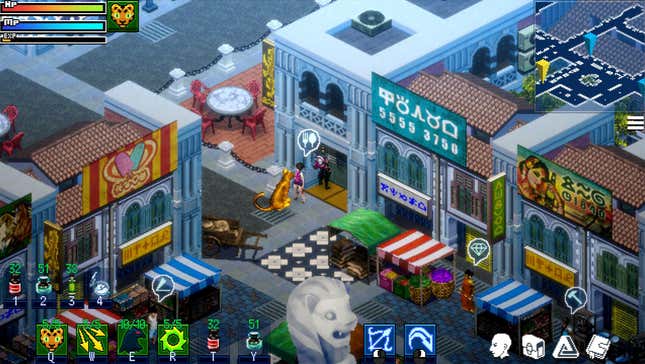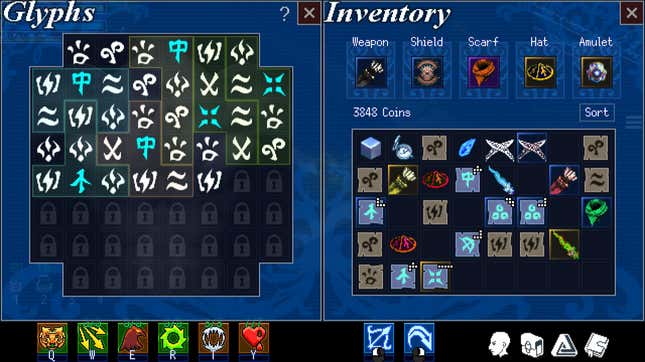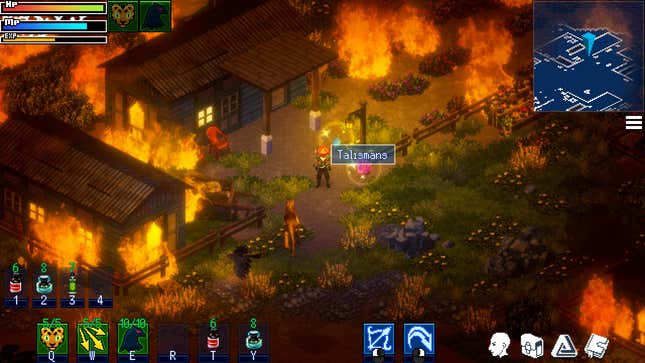Nice Recreation Move Motion RPG Has Extra Unique Concepts Than Diablo

I can not think about how daunting it should be to start making a Diablo-like action-RPG. Not solely are there so only a few of them, however these which can be recognized are behemoths. Diablo, clearly, then Titan Quest, Torchlight, Grim Daybreak… Who’d need to intentionally step into their shadows, particularly with Diablo IV popping out subsequent week to a refrain of stellar evaluations. Now think about trying it anyway, when there’s simply two folks making the sport. That’s Ghostlore, simply launched to Xbox Recreation Move, and wow, it succeeds.
To be a Diablo-like, there are just a few containers that should be ticked. You want an isometric perspective, 1000’s of enemies to assault with an ever-growing variety of abilities, portals to shops, and most of all, a near-infinite quantity of loot. All of those are extremely powerful asks for any developer, demanding not solely a daunting quantity of content material to create, but additionally a spiderweb of features to completely steadiness. I can instantly see why most wouldn’t need to attempt. And it solely grows my respect for builders Andrew Teo and Adam Teo (not associated), who had been undaunted.
Ghostlore achieves the entire above, solely slipping barely on problem, and even provides just a few distinctive twists of its personal to the format. A whole lot of that is because of a substantial amount of sense in relation to scope.

Bringing the RPG motion to Southeast Asia
Described as an “Eastpunk” sport by its creators, Ghostlore takes its inspiration from Southeast-Asian folklore, together with mythologies from Singapore, Malaysia, China and Indonesia, set in a peculiar conflation of the trendy world and monster-infested planes and forests. Rendered in beautifully drawn sprites, the world has a wise ‘90s look to it, whereas enjoying like a traditional ARPG, delivering all of the enemy-bashing, loot-scooping antics you’d anticipate from the style. Ghostlore then provides in distinctive enemies, together with a captivating bonus system, and the flexibility to mix courses to create entire new units of abilities and assaults.
For probably the most half, what you’re getting right here. There’s a hub city with quest-givers, retailers, and that one who’ll take away gems out of your gear, or gear out of your gems. You then go off to completely different grayed-out areas, exploring and attacking and looting, leveling up, switching gear, getting livid that you just simply discovered a greater defend proper after you spent all of your money and gems enhancing your present one, and chugging well being and mana potions like a strung-out wizard.

However between these acquainted features are some actually neat concepts. (Don’t hate me if you happen to’ve seen them elsewhere—they had been new to me.) The primary is the Glyph system. Glyphs are discovered amongst loot in huge portions, every with a boosting property, like, say, “+12% elevated minion HP,” or, “+81 MP”. These are positioned in a tiled grid subsequent to your stock, during which new areas unlock as you enhance your degree. (By the tip of the sport I had 49 of the 60 whole open.) Nevertheless, you can even discover Compound Glyphs, which can be five-tile shapes, pentominoes if you’ll, that then enhance the properties of all the opposite glyphs that fall inside their tiles. It’s an entire mini-game in itself, attempting to suit your greatest Compound Glyphs in the very best association into the grid. And for min-maxers, it’s manna from heaven.
One other implausible concept I need to see copied in all places is how Ghostlore handles courses. In the beginning you select from one among six—Sentinel, Feral, Exorcist, Hashashin, Geomancer and Adept—after which unlock slots in one other grid that let you select from their collection of abilities. You possibly can swap these in an out everytime you need, and rapidly unlock extra slots to incorporate extra abilities. Or, you possibly can select to fit a Ability Modifier or Class Bonus, the previous boosting different abilities on that row of the grid, the latter unlocked for each 4 tiles stuffed from that class. But it surely will get way more attention-grabbing once you attain degree 15.
At this level, you possibly can add a second class to your character, and thus entry all their abilities, too. However in a splendid function, if you happen to place specific abilities from both class subsequent to at least one one other within the grid, they mix to create a 3rd skill, distinctive to that particular class mixture. Put Sentinel’s Summon Crows subsequent to Feral’s Unleash, and the 2 mix to create Summon Sunbirds. These are extra highly effective creatures, used to assist when attacking enemies. Or put the Exorcist’s Exorcise subsequent to the Hashashin’s Dervish, and the result’s Summon Taming Sari, and assortment of possessed blades that battle alongside you. Get to degree 30 and you’ll add a 3rd and remaining class, and begin making much more combos in your talent grid.

The problem with Diablo-likes
So many features to tweak will come as a delight to those that play Diablo-likes to meticulously refine their characters. But in addition, for individuals who simply need to hit stuff with a stick, it’s all potential to make use of with a extra slapdash perspective and simply kinda hope it’s serving to.
That does carry us to Ghostlore’s vital concern: problem. There’s not sufficient of it. It’s necessary to learn this figuring out I’m normally the particular person advocating for higher Simple modes, or being livid about problem spike-shaped bosses, so this isn’t about bravado or elitism. It’s simply genuinely too simple for too lengthy, to some extent the place for the primary 25 ranges I by no means used a well being potion. (I’m on degree 39 now, enjoying post-game content material.) On this style, that’s not essentially a horrible concern, given what number of play ARPGs nearly like idle video games, one thing to click on on whereas listening to a podcast. But it surely’s positively extra enjoyable as soon as it begins getting trickier. (It’s price noting there is a permadeath mode, nevertheless.)
End the principle story, although, and also you get entry to some fully new areas that supply a a lot larger diploma of problem, which is splendid stuff. There’s additionally native co-op, and naturally the replayability of attempting completely different class builds.
Ghostlore clicked for me simply as Titan Quest did, albeit on a smaller scale. However that’s a promoting level right here too—this isn’t going to take over your life as Diablo IV would possibly subsequent week, however slightly give you a shorter burst of enjoyable, and for a fraction of the value.



